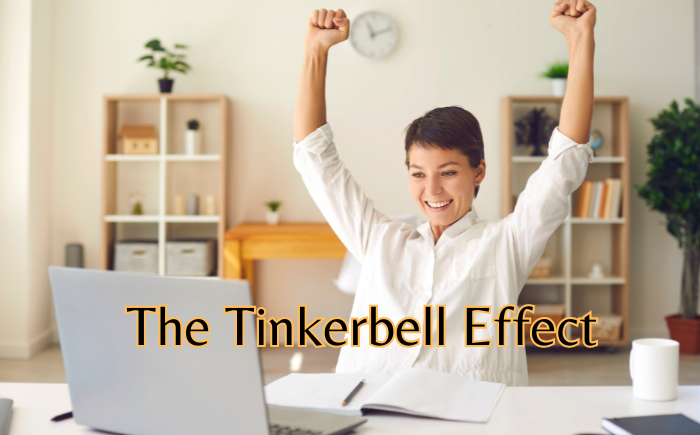Believe It to Achieve It: The Tinkerbell Effect and the Power of Perception
Do you believe in fairies? If you ever watched Peter Pan, you’d remember how the audience’s belief was crucial to Tinkerbell’s survival. This isn’t just a whimsical idea confined to Neverland; it’s a phenomenon that exists in the real world, known as the “Tinkerbell Effect.”
In this article, we’ll explore the corners of our lives where the Tinkerbell Effect flutters its wings. From the economy to personal achievements, we’ll see how belief shapes our world. We’ll also look at how to harness this power for our benefit and consider the limits of belief without action.
So clap your hands if you believe, and let’s embark on a journey to discover the magic of the Tinkerbell Effect.
What is the Tinkerbell Effect?
The Tinkerbell Effect is a term coined to describe things that exist only because we believe in them. It’s a fascinating concept that finds its roots in the power of collective belief. The more we believe in something, the more likely it is to become a part of our reality.
This effect takes its name from Tinkerbell, the fairy in J.M. Barrie’s “Peter Pan,” who is revived from near death by the belief of children. Remember the scene where Peter Pan asks the audience to clap if they believe in fairies to save Tinkerbell? It’s a moment that perfectly captures the essence of the Tinkerbell Effect.
Just as the clapping and belief of the audience breathed life back into Tinkerbell, our collective beliefs have the power to shape our reality in more ways than we realize.
The Power of Belief


Belief is indeed a mighty force, akin to an invisible hand that guides us toward the remarkable. It’s the spark that ignites the spirit of adventurers and the quiet whisper that pushes scientists to make new discoveries. When we hold a deep-seated belief in our capabilities, it’s as if we’ve laid down a yellow brick road towards our very own Emerald City of success. This concept goes beyond mere pep talk; it’s a principle supported by solid evidence.
For instance, consider the underdog sports team that defies odds to win a championship or the small start-up that grows into a tech giant. These stories are not just about luck; they’re about people who believed they could achieve greatness—and did. Research, too, nods in agreement. A study published in the Journal of Personality and Social Psychology suggests that self-belief is a critical determinant of success in various domains, from academic performance to sports.
This connection between belief and action is not just about having confidence. It’s about creating a self-fulfilling prophecy. When we believe we can achieve something, we’re more inclined to put in the work, to persist through challenges, and to attract the support we need. Like Thomas Edison’s relentless pursuit of the electric light bulb, our belief fuels our persistence. He famously said, “I have not failed. I’ve just found 10,000 ways that won’t work.” His belief in his eventual success kept him going, and it can keep us moving forward, too.
Belief is not a magic potion, but it’s the next best thing—a catalyst that can propel us to take meaningful, determined action towards our goals. When we embrace belief as our ally, we’re already halfway there.
What do I do when my life is a mess?
Tinkerbell Effect in Action
We see the Tinkerbell Effect in various aspects of life, from the economy to personal health. For instance, a placebo, with no active medical ingredients, can sometimes improve a patient’s condition simply because the patient believes it will work. This is the Tinkerbell Effect at play in medicine. Similarly, in the financial world, the value of money itself is largely based on our collective belief in its worth.
There are countless stories of individuals who have overcome adversity through belief. One such story is that of Roger Bannister, the first person to run a mile in under four minutes. Before he accomplished this feat, most believed it was impossible. But Bannister’s belief in himself changed the world of athletics forever.
Psychological research supports the idea that our expectations can influence reality. Studies have shown that teacher expectations can affect student performance, known as the Pygmalion effect. This is a form of the Tinkerbell Effect, where belief translates into tangible results.
Belief and You


Harnessing the power of belief can transform your personal and professional life. Start by setting positive expectations for yourself and visualize achieving your goals. Surround yourself with people who believe in you and your dreams. Remember, belief isn’t just about wishful thinking; it’s about creating a mindset that empowers you to take action.
Harnessing the power of belief truly has the potential to revolutionize both your personal and professional spheres. It all begins with the seed of positive expectations.
Picture yourself not just reaching, but exceeding your goals. Imagine the satisfaction and joy that comes with each milestone achieved. This isn’t just daydreaming; it’s a proven technique called visualization, which athletes and top performers use to enhance their output.
Now, consider the company you keep. Surrounding yourself with supporters—friends, family, mentors—who champion your aspirations can amplify your confidence. Their faith in you acts as a mirror, reflecting back the strength you possess but sometimes overlook. It’s like having a personal cheer squad; their belief can lift you over hurdles and through tough times.
Elevate Your Life: The Power Behind Choosing Gratitude
The Flip Side: When Belief is Not Enough
It’s important to recognize that belief alone isn’t a magic bullet. While it’s a powerful motivator, action is the real catalyst for change. Believing you’ll ace an exam won’t help much if you don’t study.
Remember, the core of belief is action. As the famous artist Vincent Van Gogh once said, “Great things are done by a series of small things brought together.” Each step you take, propelled by belief, weaves the tapestry of your success. Studies have shown that people who maintain a positive outlook and believe in their capacity for success are more likely to achieve their goals.
This study shows how chronic self-views influence (and potentially mislead) estimates of performance.
Belief isn’t a magic spell—it’s the fuel that powers the engine of your will to act. It’s the firm ground on which you stand when you set out to conquer your daily tasks and long-term projects. By cultivating a belief in yourself, you’re not just hoping for a better future; you’re building it, one confident step at a time.
The Tinkerbell Effect has its limits, and understanding this will help you balance optimism with pragmatism.
The Scarcity vs Abundance Mindset: A Battle for Your Potential
Conclusion
The Tinkerbell Effect is a reminder of the power of belief and how it can shape our reality. By believing in ourselves and our abilities, we can create positive changes in our lives. However, it’s crucial to pair this belief with action. As J.M. Barrie once wrote, “The moment you doubt whether you can fly, you cease forever to be able to do it.” Keep the magic of belief alive in your heart, and you’ll soar to new heights.
So, the next time you’re facing a challenge, channel your inner Tinkerbell, believe you can, and then make it happen with your actions.







